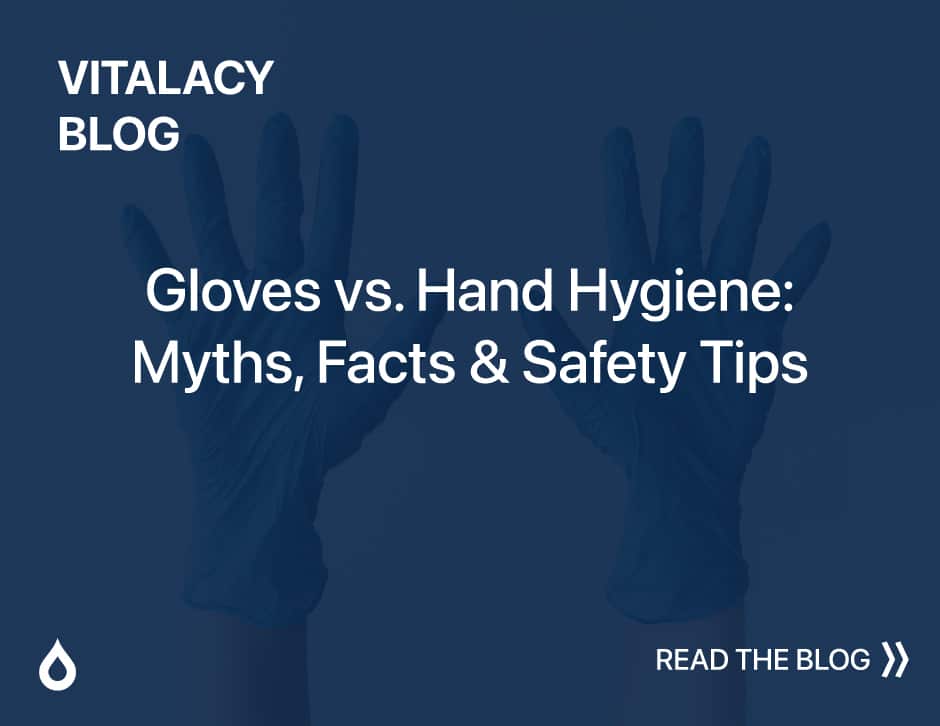
Pathogens. Everywhere. While a few germs can actually be a good thing (bolstering immunity and whatnot), the overwhelming influx can become a problem in the workplace. Depending on the industry, this can become an even more prominent problem (for example, medical facilities).
This begs the question — how can the spread of contagions be minimized or even prevented altogether?
How germs spread
The modes of transportation germs use to get from point A to point B are really quite ingenious. Depending on the type of pathogen and the systems it infects, diseases can be spread in just about every imaginable way.
Airborne transmission
One of the most common types of diseases, airborne illnesses, are spread via oral or nasal secretions that are aerosolized through the mouth or nose and then inhaled by others. Coughing and sneezing are the most common means for airborne illnesses to be spread but even a particularly virulent individual can spread these germs by speaking in close proximity to others.
Skin-to-skin contact
Skin-to-skin contact is another way pathogens are easily and frequently spread from one individual to another. For instance, shaking hands with an infected individual and then not properly sanitizing one’s own hands after the encounter can lead to the spread of infection.
Contaminated food or beverages
Perhaps one of the most unsavory to consider, the contamination of food is a prevalent and easily prevented way for germs to find their way from one host to another. This contamination typically occurs when an individual does not wash (or properly wash) their hands and then handles food or beverages. This leads to contamination of the food or drinks with fecal matter. The pathogens are unknowingly consumed and then cause infection to occur. Good hand hygiene can be practiced, limiting the risk of this type of germ transmission.
Direct contact with bodily fluids
Last but not least, germs are easily transmitted from one person to another via bodily fluids. These include blood, saliva, urine, and feces. Contact with mucous membranes, cuts, abrasions, or via needles or other sharp items are the modes through which infection via bodily fluids can happen.
A few of the most prevalent workplace bugs
There are a number of infectious ailments that can bring down entire workforces with their sheer virulence and tenacity. Understanding the more common ailments and how they spread can help avoid a potentially serious workplace outbreak.
Influenza
Commonly known as “the flu”, respiratory influenza is most frequently spread through airborne infection. An individual with the flu may suffer from fever, malaise, cough, runny nose, inappetence, sore throat, aching muscles, and fatigue.
Flu can be contracted through the air (airborne) or from direct, skin-to-skin contact.
Common Cold
While not particularly dangerous, the common cold can result in lost work and performance. Runny nose, sore or scratchy throat, mild cough, and low-grade fever are the symptoms associated with the common cold. It, as with flu, is most easily spread via aerosolization or skin-to-skin contact. This means that if an office mate sneezes on their hands, doesn’t wash, then grabs a cookie from the plate in the break room, there is a decent chance of contracting their cold if you partake of a cookie touched by him or her.
E. coli
E. coli is a common but preventable disease that is typically spread through the contamination of food or drinks. Symptoms of E. coli run the gamut, from mild gastrointestinal discomfort to vomiting, diarrhea, dehydration, stomach cramps, and fever.
Communal eating venues such as potlucks or workplace buffets are easy places to become infected. Whether the carrier is preparing the food or merely serving themselves with unwashed hands, it’s possible to catch E. coli fairly easily from contaminated food or surfaces.
Keeping oneself healthy
Avoiding illness lies largely in how an individual controls their exposure to germs. It’s not a matter of if but when they’ll encounter pathogens. They’re everywhere — in the air and on surfaces.
Practicing good germ avoidance habits is the first step towards preventing infection. Regular handwashing is perhaps the most important action an individual can take to limit their exposure to germs.
Another is in food and beverage handling. Using napkins or paper plates for food (rather than setting food directly on a surface) provides a certain level of protection against the germs that may be lurking on desks, counters and tables. Covered cups, such as travel mugs can also help to keep errant aerosolized germs from making their way into beverages.
For those that work directly with patients in the healthcare industry, removing work clothing and showering upon arriving home is helpful to avoid contaminating surfaces in their homes with pathogens that may have been picked up on clothing during the workday.
Preventing the spread of workplace germs
Trying to keep everyone healthy in a workplace can be a full-time task. Each individual has different hygiene practices, making it difficult to completely eliminate the presence of germs in the workplace.
There are, however, good practices that can help even the largest employers keep their workers healthier and happier.
Place hand sanitizing stations in convenient areas
The advent of hand sanitizer has made it easier than ever for people to eliminate larger numbers of germs on their hands. Usually made of alcohol and a variety of scents and other ingredients, these substances can be placed in easy-to-use dispensers. These dispensers, mounted on walls, encourage people to regularly sanitize their hands.
While it may not be as effective as soap and water and proper washing techniques, it can go a long way toward spreading germs from one host to another.
Good places to include these devices? High-traffic areas including walls near stairwells, outside of break rooms, outside of bathrooms (if they don’t wash, they may at least sanitize!), and near building entrances.
Additionally, sanitizing wipes made specifically for office equipment can help cut down on the number of germs being swapped back and forth on surfaces such as communal office phones, faxes, and copiers.
Teach proper handwashing techniques
Hand washing seems like it should be a no-brainer. Unfortunately, there is a right way to wash hands and a wrong way. Awareness of numerous situations that would warrant handwashing should also be stressed. These include:
- After sneezing, coughing, or nose-blowing
- Prior to touching food, whether it be to prepare or to eat it
- Once done petting animals
- Following using the toilet
- Before performing other tasks such as blood draws or swabs
- Shaking hands with another individual
The CDC (Centers for Disease Control) has developed a handwashing guide. Print it out and place it near sinks in break rooms and restrooms to encourage people to take the time to cleanse their hands.
Preventing the spread of illness isn’t completely avoidable. Reducing the likelihood of germs being spread is, however, possible. Both training and common sense can make a huge difference in the health and well-being of staff in the workplace.
Jennie Eilerts is a freelance medical writer based in Denver, Colorado. She specializes in human and veterinary medicine, having spent 20 years in a clinical setting for the latter. When she’s not busy writing she can be found hiking, rock hunting, exploring Denver and spending time with her husband and horses.
Request a demo of Vitalacy’s Automated Hand Hygiene Monitoring Solution today!
Author
-

Vitalacy is committed to reducing patient harm in healthcare through better hand hygiene and patient safety solutions. Bluetooth-enabled smart sensors and wearables help improve outcomes and Leapfrog Hospital Safety Grades.
View all posts




